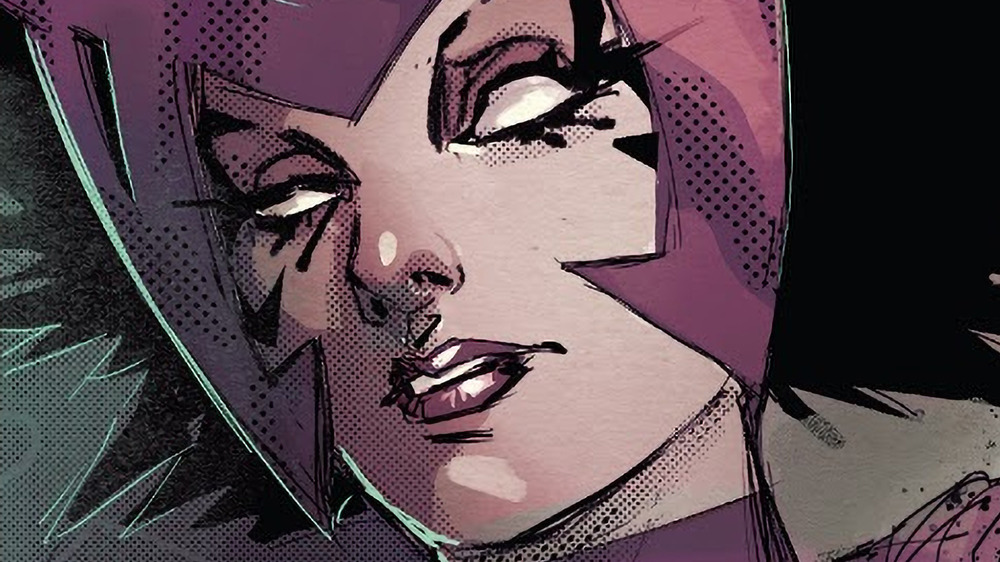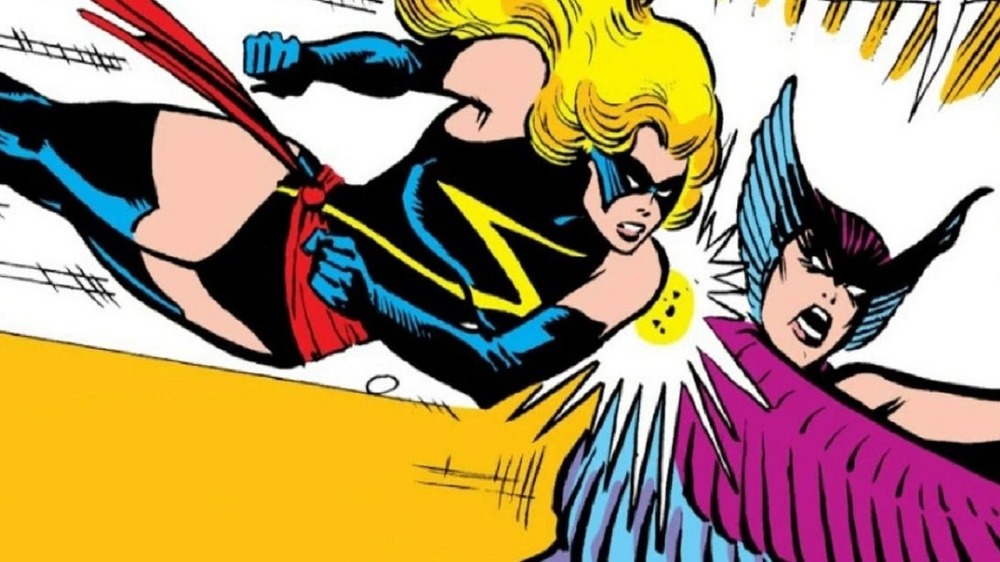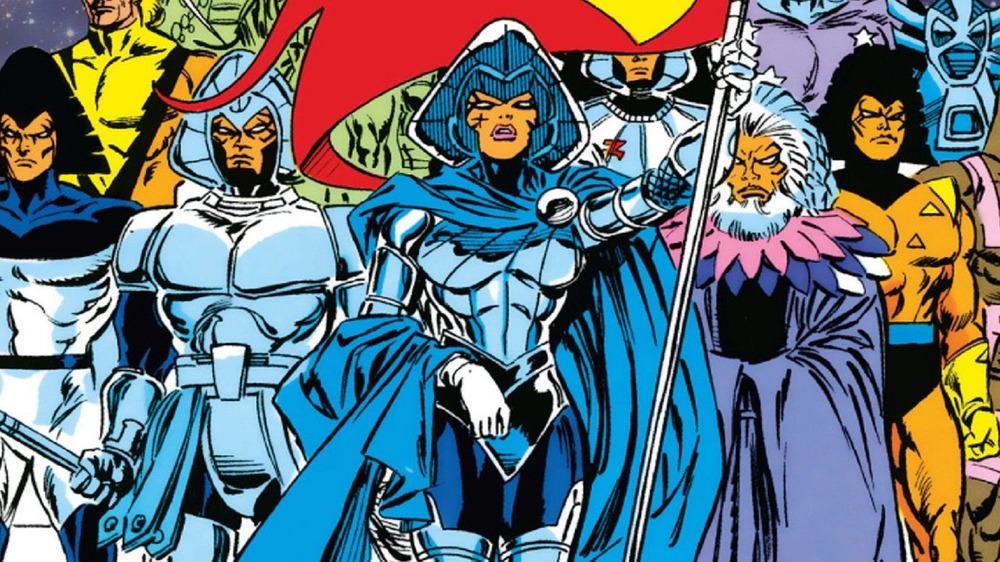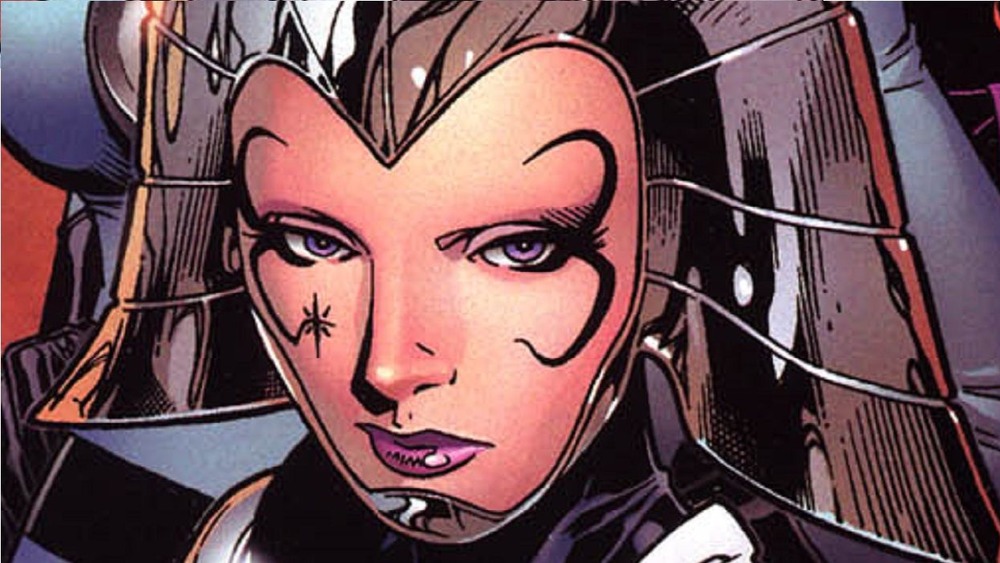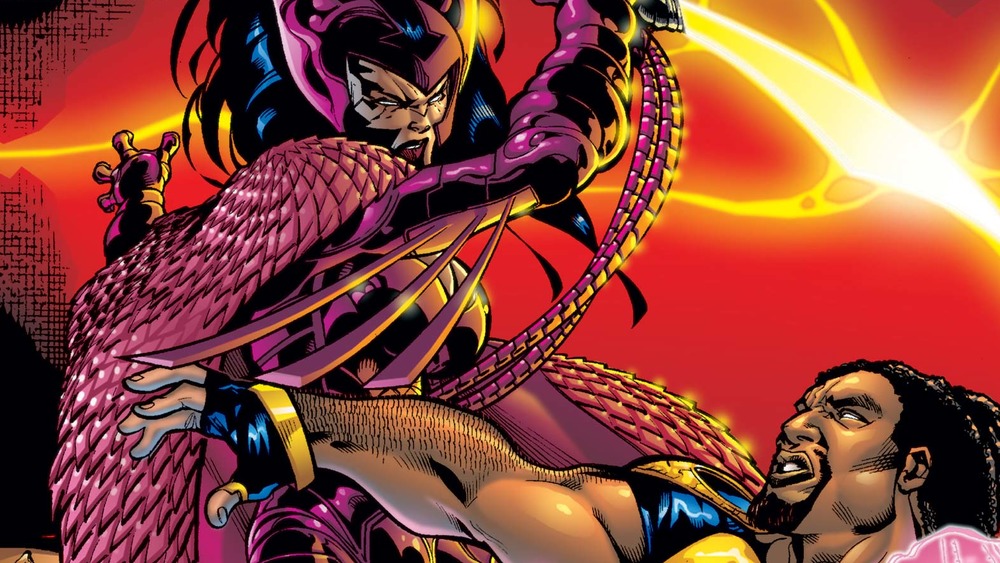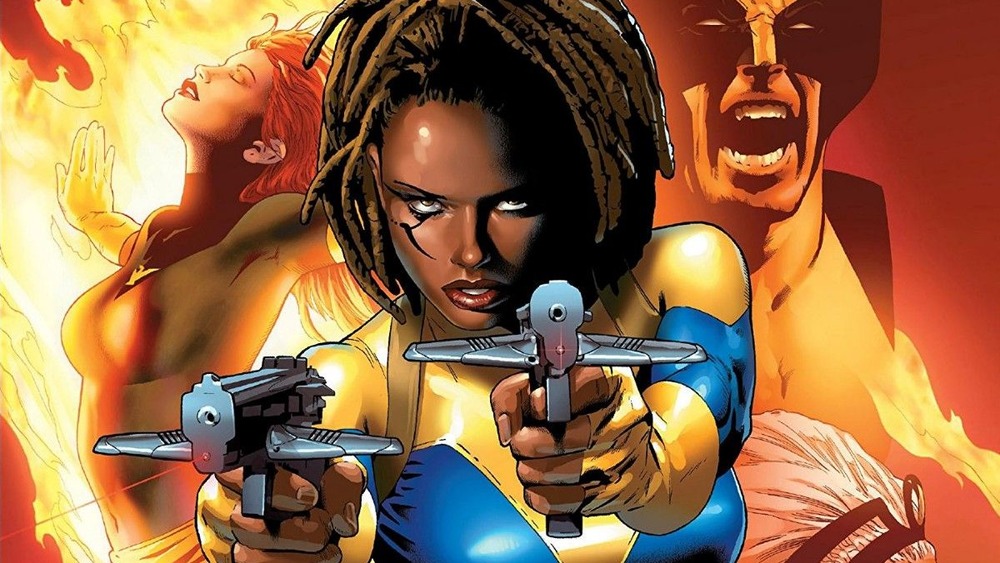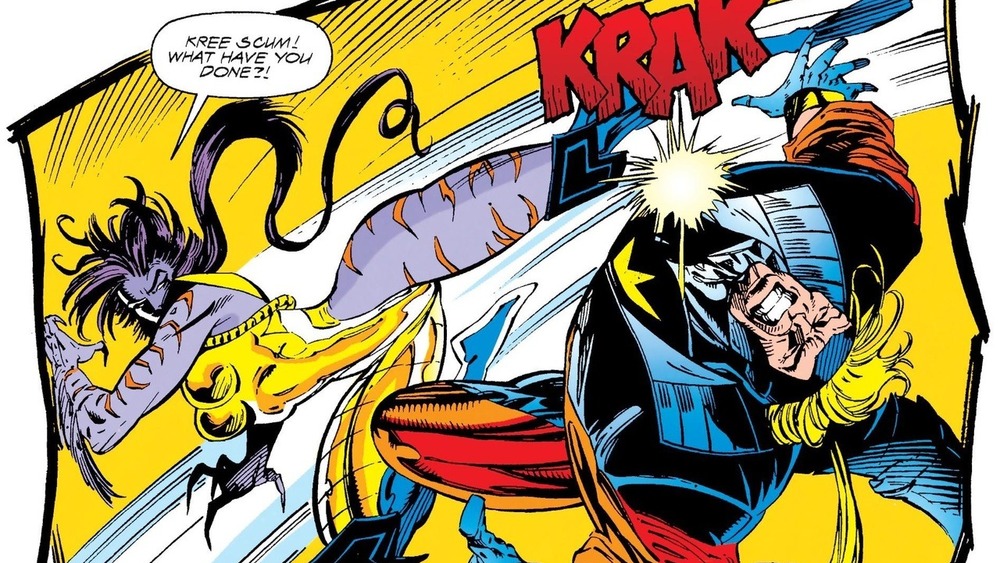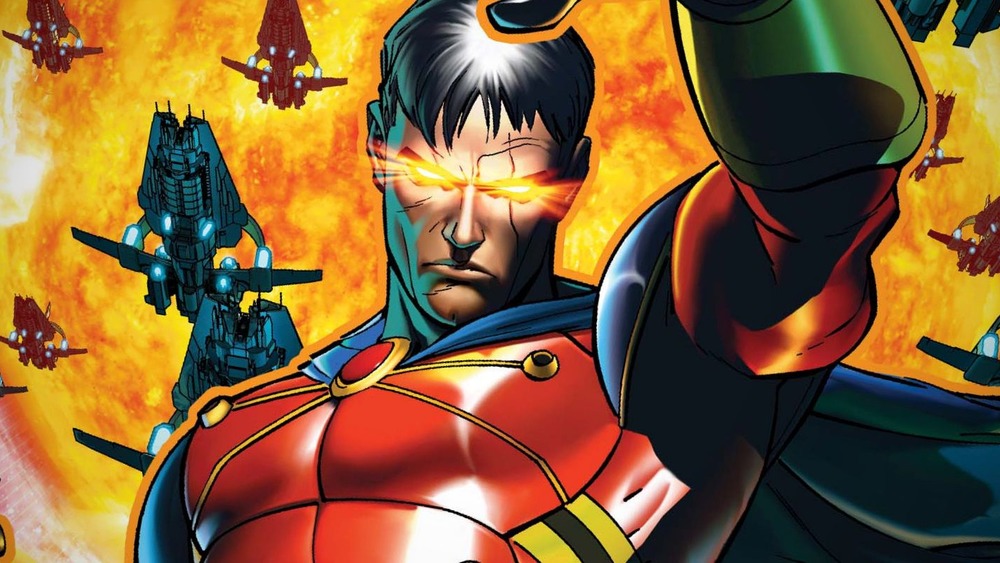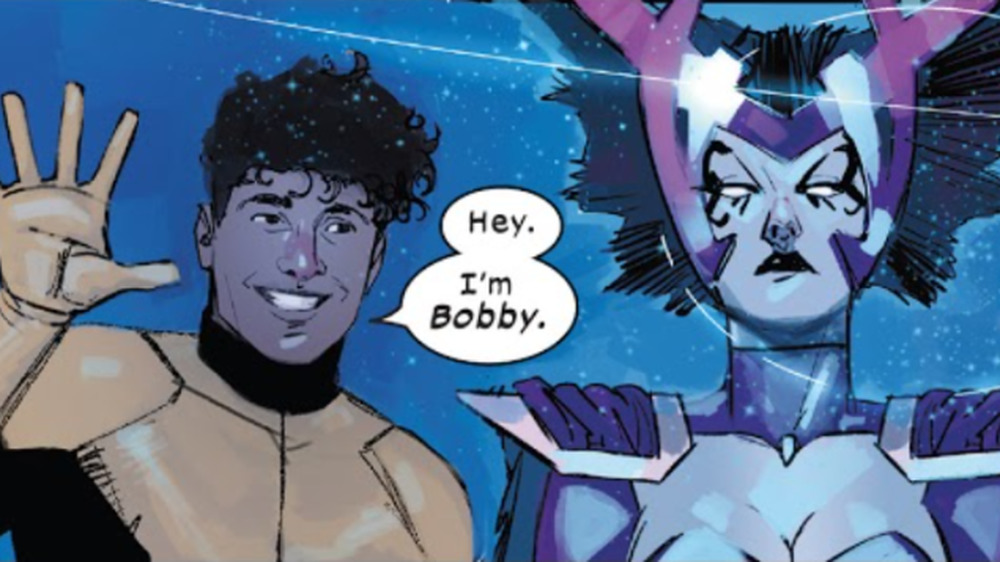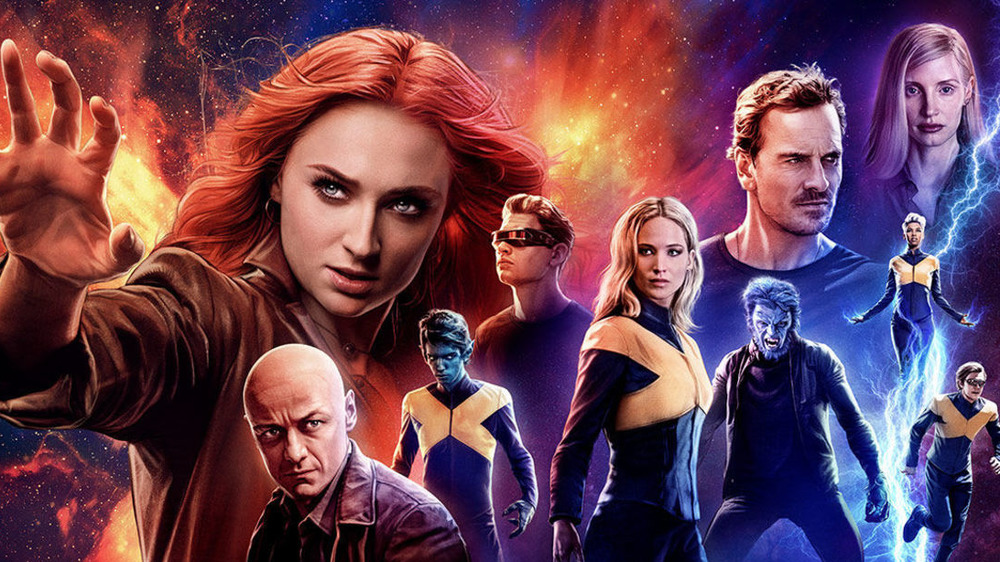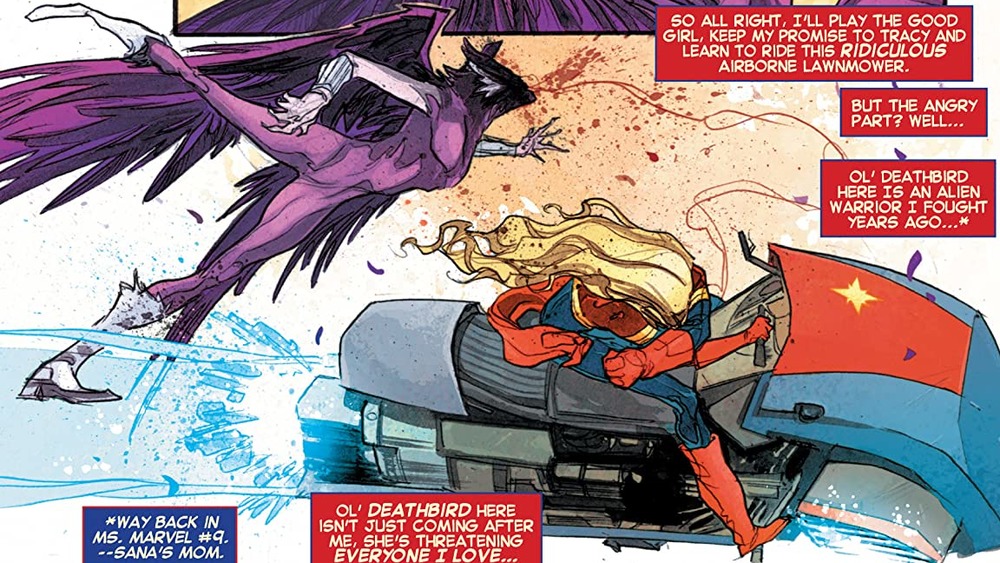The Untold Truth Of Marvel's Deathbird
Marvel Comics' history is full of bad guys. Some are maniacs, driven by the desire to create mayhem. Some are mutants with potent political agendas. Some are morally ambiguous thieves, more interested in personal gain than international domination. Some are aliens, with lives inextricably intertwined with intergalactic wars many lightyears beyond Earth. Deathbird, the Shi'ar royal assassin, is a member of this last group. She's bad. She's feathery. She's the black sheep of a powerful royal family. She's tangled with everyone from the X-Men to Captain Marvel. And no matter what, she's always ready to come back for more.
Did you read the phrase "Shi'ar royal assassin" and think to yourself, "I need more context to understand those words"? That would be understandable: Even the most seasoned Marvel fan can't hope to keep track of every single corner of this vast fictional universe. Deathbird is a character worth meeting, however, with a bright future in the Marvel universe. We're here to deliver the details on this longtime villainness, one interstellar skirmish at a time.
Deathbird swoops into comics history
Deathbird is often described as an X-Men adversary instead of a Captain Marvel baddie, despite her recent tussles with Carol Danvers. That's not a mistake: The entity whose tax forms identify her as Cal'syee Neramani has been more prominently featured in the X-Men family of books than she has in Marvel's non-mutant wing of titles.
However, before Deathbird finds herself plotting against Earth's Mightiest Mutants, she encounters Carol Danvers (who was still using the codename "Ms. Marvel" at the time) in Ms. Marvel #9 (1977). Essential Marvel comics scribe Chris Claremont co-created Deathbird with artists Dave Cockrum and John Byrne, and also penned the bulk of the 1977 Ms. Marvel series. Claremont is best known for writing Uncanny X-Men for a 16-year period that saw the publication of definitive stories like "The Dark Phoenix Saga," "Days of Future Past," and "God Loves, Man Kills." Basically, Deathbird was co-created by Marvel royalty.
The cover of Ms. Marvel #9 introduces the feathered fiend as "the ... deadliest foe the female fury has ever faced!" These words crown a depiction of Deathbird swooping in on a seemingly frightened Danvers, threatening her with "razor-sharp talons." Deathbird's ability to intimidate Carol Danvers does not last very long, of course, as Carol quickly shows Deathbird who's boss.
The Shi'ar Empire's long, strange story
The Shi'ar are a humanoid alien species whose vast empire dominates millions of other planets and countless intergalactic species. The Shi'ar are descended from an alien cousin of Earth's birds: This explains the avian codename motif of some of its most prominent warriors, Deathbird included.
The cosmic flock first appears in X-Men #97 (1976), when Imperial Majestrix Lilandra — Deathbird's younger sister, and, at the time, the Shi'ar Empire's head of state — haunts Professor Xavier's dreams with cryptic messages, eventually revealed to be requests for the X-Men's help in dispatching her power-crazed brother, D'Ken. Not long after, the Shi'ar play a significant role in preventing Jean Grey, transformed into Dark Phoenix, from destroying all existence. Once that debacle gets sorted out, the Shi'ar pop up in countless other X-Men tales, and occasionally intervene in matters pertaining to the Avengers and/or the Guardians of the Galaxy. Often, the Shi'ar help the good guys — but sometimes, they definitely don't.
We know you want to ask, "If Shi'ar are descended from birds, does that mean their babies hatch out of eggs?" The answer is yes. It is exactly as weird as you're picturing.
Sisterly squabbles, Shi'ar style
Characters in superhero comics often come in twos. Just about everyone has a good or evil (or morally ambiguous) counterpart: Spider-Man has Venom, Wolverine has Sabretooth, and Lilandra of the Shi'ar has her unstable big sister Cal'syee, AKA Deathbird.
Like many other royal siblings (fictional and otherwise), Lilandra and Deathbird often feud over who gets to wear the crown. Though Deathbird is the elder of the two, an incident that results in the death of at least one other immediate family member — Lilandra describes it as a "matricide" in Uncanny X-Men #156 (1982) — prompts her banishment and the stripping of her royal rank. Eventually, Deathbird gets to be majestrix anyway: She marries the mutant Vulcan before he squirms his way into the title of Majestor of the Shi'ar Empire during 2009's War of Kings series. An assassin under Vulcan's command murders Lilandra in War of Kings #4, but considering the provisional nature of death in X-Men stories, we can more-or-less assume Lilandra will reemerge sooner or later. Then, the war between sisters is likely to resume, as brutal as it has ever been.
Deathbird and Bishop beat the odds
A bunch of X-Men-affiliated characters made their debuts in the '90s, but plenty of them did not demonstrate much in the way of staying power. The ones who did, however, became beloved fan favorites: Deadpool, Gambit, Jubilee, and Monet St. Croix are among this number, as is Bishop, who's basically Cable without the convoluted backstory and X-Force flunkies.
Deathbird and Bishop meet while fending off a Phalanx invasion of Chandilar, in an arc that transpires from Uncanny X-Men #341 through #345 (1997). Apparently, there's nothing sexier than life-or-death combat against an all-consuming hive mind, as the two quickly enter into a relationship. The pair hits their inevitable rough patch in Uncanny X-Men #372 (1999) – but by the standards of good guy/bad guy couples in the Marvel universe, two years of real-world time is a romance for the ages. When you compare them to, say, Daredevil and Elektra, or Spider-Man and Black Cat, Deathbird and Bishop are basically a monument to love conquering all.
Aliyah Bishop, daughter of Deathbird
Chris Claremont returned to the mutants who made him famous in X-Men: The End (2004). As sometimes occurs when iconic creators revisit IPs they enjoyed great success with decades earlier, the results are ... interesting. For one thing, roughly half of all mutant superheroes and a pile of affiliated characters die. Kitty Pryde becomes president of the United States. Gambit turns out to be a clone of Mr. Sinister. Very little of it makes a lick of sense within present-day X-Men continuity.
Deathbird joins the ranks of The End's fallen after an encounter with the Brood — Marvel's version of the xenomorphs from the Alien franchise — doesn't go her way. But she lives on in Aliyah, the daughter she had with Bishop, and an intergalactic adventurer in her own right. In fact, Aliyah serves as one of The End's principal protagonists.
As the comics have not revisited the Deathbird-Bishop romance in a while, we don't see a ton of additional Aliyah Bishop appearances following the 2006 end of The End. The prospect of Bishop and Deathbird's alternate reality daughter showing up in the MCU somewhere down the line sounds profoundly unlikely, but hey — imagine telling someone from 2002 that kids wear Rocket Raccoon backpacks now. Aliyah has a chance!
Deathcry's murky parentage
1990s superhero comics endured an influx of "edgy" and "dark" characters. Some remain wildly popular, while others are remembered in roughly the same way Itchy and Scratchy fans remember Poochie. The Avenger known as Deathcry falls into the latter category. First appearing in Avengers #363 (1993), Deathcry's vaguely lycanthropic features immediately call to mind Feral, a member of that era's X-Force who critics often belittle as a third-tier Wolverine knockoff. As Edward Norton's character in Fight Club might say, Deathcry looks like a copy of a copy of a copy of a copy.
Deathcry joins the Avengers shortly following her debut, and sticks around until Avengers #399 (1996). The fact that she spent three real-world years in ongoing Avengers comics, yet remains a virtual unknown, should tell us something about Deathcry's popularity. It also speaks to how much the cultural influence of the Avengers brand has changed since the early '90s.
While Deathcry has been hinted to be Deathbird's daughter on numerous occasions, her official Marvel bio makes no mention of any direct genetic link to the Shi'ar royal family. Let's remember, Deathbird is not a nice person: We wouldn't put it past her to lie about her relationship to a United They Stand-era Avenger with a name, powerset, and appearance straight out of a Mad Libs filled out by Rob Liefeld.
Deathbird's evil husband
Deathbird's had plenty of relationships with superpowered buff dudes, but she's only been married once. As was once the case with her younger sister Lilandra, the union briefly turns her into a member of a prominent family among Earth's mutants.
In X-Men #23 (1993), Mr. Sinister lets it slip that Scott and Alex are not the only two Summers brothers out there, as had been previously assumed. Throughout the '90s, readers speculated about the identity of the third, secret Summers. Maybe he was Gambit? Or Adam X? Or even Apocalypse?!
Then, in X-Men: Deadly Genesis (2006), fans found out it was Vulcan, a complete evil maniac. One thing leads to another, and pretty soon, Vulcan winds up marrying Deathbird and conquering the Shi'ar Empire, as is documented in Uncanny X-Men #485. Later, he's apparently killed in a battle against Black Bolt. But as of the last time we saw him in X-Men #10 (2020), he's living on the moon with the rest of the Summers bunch, having apparently buried whatever hatchet there was between himself and Cyclops.
Deathbird and Sunspot give love a try
While Deathbird's capacity for romance is vast, her capacity for violence is even more prevalent. For instance, that time she hooked up with Sunspot? There was blood everywhere. As chronicled in New Mutants #1, #2, #5, and #7 (2019-2020), Sunspot and his fellow New Mutants find themselves on a space quest to retrieve their old pal Sam Guthrie, AKA Cannonball. As the New Mutants make their way to Chandilar, the Shi'ar government enlists them to pick up the hitherto exiled Deathbird, because the young Majestrix-in-training Xandra Neramani requires her aunt's ongoing counsel. A secret faction of Shi'ar officials with a hidden agenda send a squad of Death Commandos to slaughter Deathbird and her accompaniment, but most of these Death Commandos meet their end via stab wounds inflicted by Magik and Deathbird.
Soon after, Deathbird returns Sunspot's previously-stated affections, and Sunspot names his new spaceship after her in a grand, adorable gesture. Currently, Sunspot remains on Chandilar. Partially, this is because he is a good boyfriend ... but also, if the situation ever gets too weird, he can take a Krakoan gate back to Earth at a moment's notice.
Deathbird has yet to appear in live-action media
So here we are in a reality where the Scarlet Witch and the Vision are the primary characters of a mainstream television sensation. The comic book movie and TV show boom remains in full swing. but despite the existence of multiple X-Men films — two of which lift their stories directly from "The Dark Phoenix Saga" — we've never seen a live action adaptation of Deathbird, or, for that matter, any other Shi'ar. The closest we get is a brief mention of the Shi'ar on the FX drama Legion, but the show never follows up on it.
Hollywood has yet to manage a film that does "The Dark Phoenix Saga" justice, and the repeated choice to leave the awesome outer space bird people on the table has not helped matters. But that doesn't mean Deathbird has never been seen outside of a comic book. She's a boss battle in the highly memorable Marvel: Ultimate Alliance, a game that came out so long ago, its version of Iron Man doesn't look or talk like Robert Downey Jr. She also pops up in X-Men: The Animated Series' "Dark Phoenix" adaptation, which is arguably the most successful cross-media version of that story so far.
Captain Marvel delivers a Deathbird beat-down
Except for the introduction of Carol Danvers' pet flerken — known as Chewie in the comics and Goose in the movie, despite the fact that Disney owns Star Wars — few elements of Kelly Sue DeConnick's 2010s Captain Marvel run made it into the 2019 film. Overall, the movie is primarily concerned with the origin story published decades earlier. But we'd argue that the sardonic and righteously defiant spirit of DeConnick's run makes its way to the screen, particularly during the film's third act. Much of this spirit is present in that comic series' use of Deathbird.
If we've turned you into a Deathbird fan, we regretfully inform you that when a villain presenting herself as Cal'syee Neramani and Carol Danvers cross paths in Captain Marvel #11, our purple-clad mistress of mayhem gets her clock properly cleaned. An illness has rendered Danvers unable to use her customary power of flight, but ultimately, that doesn't matter: By the end of issue 12, Deathbird is down for the count.
Perhaps Deathbird should consider teaming up with someone else — especially if she wants a long future in the MCU. Unless her cinematic incarnation varies significantly from the comics, she won't be able to last 90 minutes against Brie Larson's Danvers in a punching contest. That'd be a really short movie.
